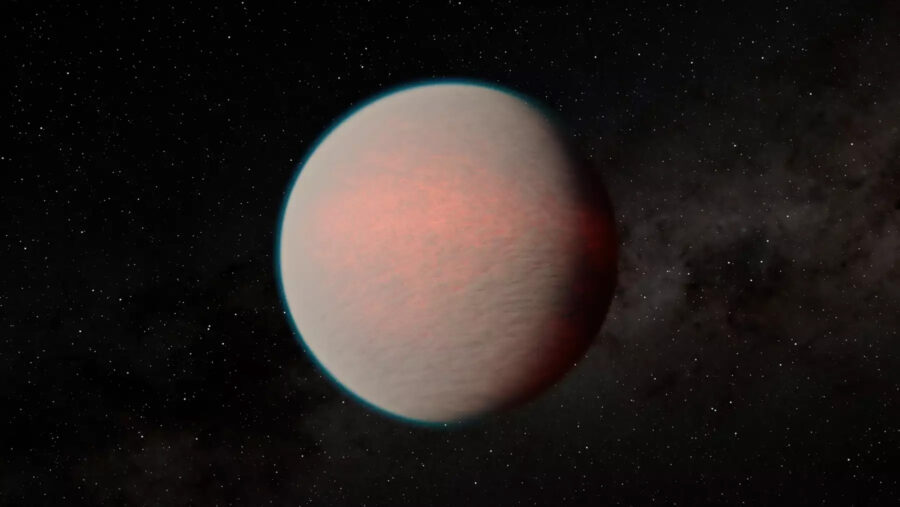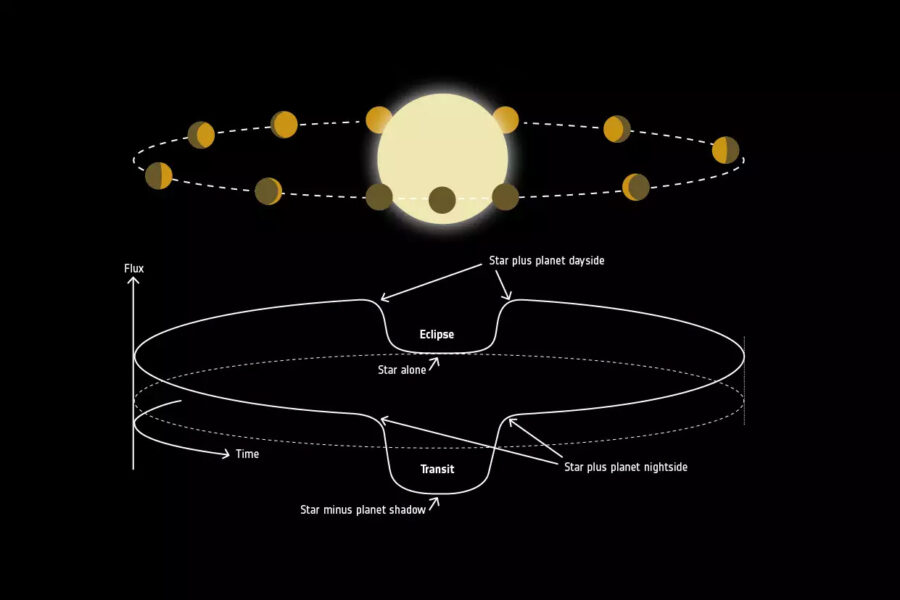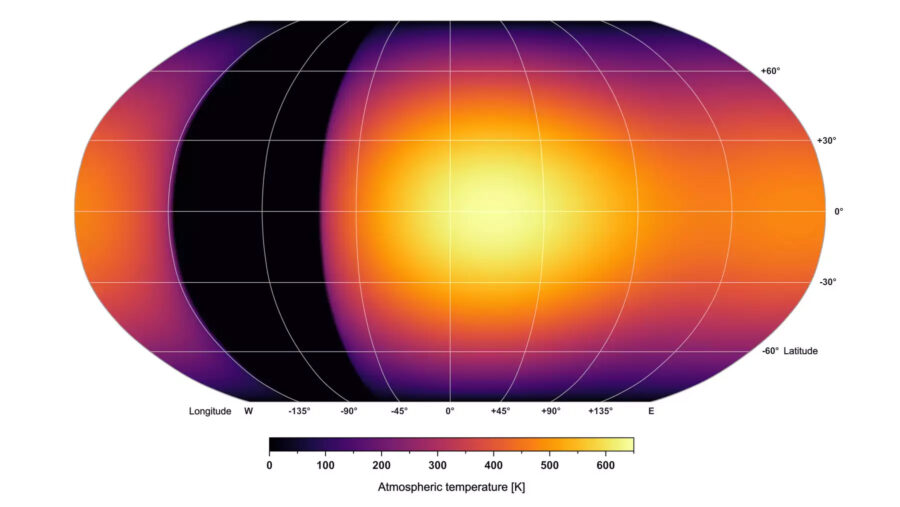Since its discovery, GJ 1214b has hidden its secrets beneath a layer of high-altitude clouds. Now, James Webb Space Telescope observations offer a new window inside the planet’s atmosphere.

NASA/ J PL-Caltech / R. Hurt (IPAC)
Astronomers armed with new James Webb Space telescope (JWST) images have gotten under the high-altitude skin of the mini-Neptune dubbed GJ 1214b. The results, published May 10th in Nature, show that this planet’s atmosphere is probably composed of some combination of water, methane, and hydrogen cyanide, all wrapped thickly in highly reflective clouds or haze.
GJ 1214b, it must be noted, isn’t habitable — and that has nothing to do with the possible presence of cyanide. Since it orbits its red dwarf star at 0.014 astronomical unit (30 times closer to its star than Mercury is to the Sun), astronomers expected this world would be scorching hot, and the new observations bear that out. The planet is tidally locked, always facing the same side toward its star, and its dayside is searing at 550K (530°F). Even its cooler, perpetually dark side is still 440K (330°F).
But the world isn’t as hot as it would be without an atmosphere. Indeed, the very presence of air affects how heat is distributed across a planet. Using the first heat map of a sub-Neptune planet, Eliza Kempton (University of Maryland, College Park) and colleagues have started to unravel this world’s mysteries.
White Whale
Astronomers have observed GJ 1214b before — a lot. It’s conveniently close to Earth (40 light-years away in Ophiuchus), and its orbit is also close to its star (it swings around every 1½ days). The latter means that the the planet transits more often, providing more opportunities for observations. GJ 1214b’s proximity to Earth and its host star also makes spectroscopic examination of its atmosphere easier.
But the planet has been rather stubborn about giving up its secrets.
From the world’s lightweight density, just a third of Earth’s, astronomers had suspected that it’s made neither of rock nor light gases but rather of water. More specifically — given the planet’s inherent heat — water vapor. But attempts at measuring the atmosphere using the Hubble Space Telescope were stymied by what appeared to be high-altitude clouds. The clouds, or perhaps hazes, blocked any deeper view into the planet’s atmosphere, at least at the wavelengths that Hubble was able to explore.
“GJ 1214b has been the white whale of exoplanet atmosphere characterization,” says Laura Kreidberg (Max Planck Institute of Astronomy, German). Kreidberg has been studying GJ 1214b since its discovery in 2009 but wasn’t involved in the current study.
Astronomers also previously used the Spitzer Space Telescope to measure the planet’s full orbit, observing the planet as it eclipses, and is eclipsed by, its star. Those observations hinted at a circular orbit and a high daytime temperature. Now, JWST observations of the full orbit, and the heat map that results, both confirm those past findings and reveal new details.

ESA

Eliza M.-R. Kempton et al. / MPIA
“Shiny”
From the distribution of temperature across the planet, Kempton’s team determined that the planet must be almost twice as reflective as Earth is, with a Bond albedo of 0.51. For reference, Earth’s Bond albedo is 0.3 and Titan’s is 0.27; in fact, in the solar system, Jupiter is the closest match to GJ 1214b’s reflectivity.
The planet’s “shininess” rules out previous suggestions that the haze enshrouding the planet is made of soot-like particles or hydrocarbon gunk known as tholins. Clear atmospheres are also ruled out because they absorb too much radiation. Exotic clouds — such as potassium chloride (used on Earth as fertilizer) or zinc sulfide — are reflective, but climate models can’t produce these clouds in the abundance that observations require. For now, the planet is holding on to the secret of what its clouds and hazes are made of.
Water, Methane, Cyanide — Or All Three
A JWST spectrum of the planet’s nightside, which faces Earth before, during, and after the planet’s transit, reveals a huge absorption feature that could be produced by some combination of water, methane, and hydrogen cyanide. (The cyanide might come about from photochemical reactions between methane and the red dwarf’s starlight.) The absorption feature is likely present on the dayside, too, but isn’t as clear.
Whichever of these molecules are present, they indicate that the planet’s atmosphere has many more heavy elements than the Sun does, maybe by factors of a few hundred. “For comparison,” Kempton says, “Jupiter is enriched in heavy elements relative to the Sun by a factor of 3, Saturn by a factor of 8, and Uranus/Neptune by a factor of 50.”
Kempton says that while the absorption feature is real, it’s tricky to say which of these molecules are responsible because their absorption bands all occur at roughly the same wavelengths. “All bets are on water,” she adds, though all three molecules could be present to some degree.
Whatever water there is would be in the form of steam or, in the planet’s interior, as hot ice or even as a supercritical liquid. “There's no swimming pool or ocean inside this planet,” Kempton says. While water may not exist there in the terms we’re used to, the waterworld scenario that scientists first hypothesized after the planet’s discovery is still in the running.
 2
2
Comments
Yaron Sheffer
May 15, 2023 at 8:47 am
"its orbit is also close to its star [...] [which] means that when the planet transits, the star’s light dims more than it would if the planet were farther out."
Monica, it seems (to me) that from out vantage point, the star to planet distance should not affect the amount of dimming. However, if we took "more" to mean "for a longer part of the orbital period" then we have a winner 🙂
You must be logged in to post a comment.
Monica YoungPost Author
May 22, 2023 at 12:29 pm
Yaron, you're right, the depth of the transit is related to the planet's size not its orbit! I've corrected the text, also noting that the more frequent transits provide more opportunities for observation.
You must be logged in to post a comment.
You must be logged in to post a comment.